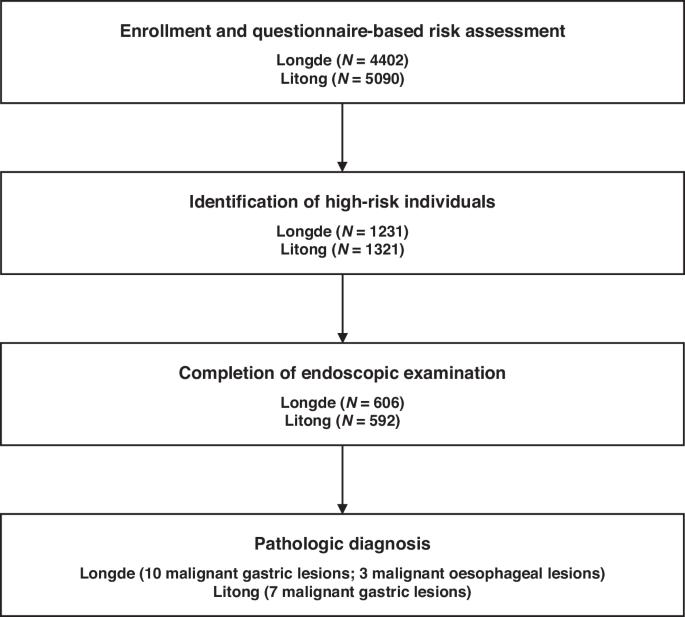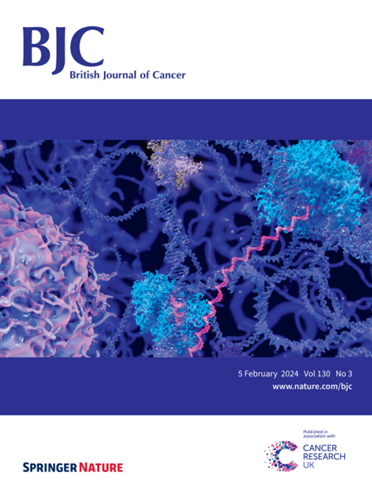基于风险的上消化道癌症筛查的效果:一项多中心真实世界研究
IF 6.8
1区 医学
Q1 ONCOLOGY
引用次数: 0
摘要
背景:通过基于问卷的定量模型评估基于风险的上胃肠道(UGI)癌症序贯筛查的可行性、有效性和成本效益。方法:我们将基于风险的筛查策略应用于宁夏陇德和黎通两个地区正在进行的政府管理的筛查项目。通过流行病学调查,邀请高危人群进行内镜筛查。结果:共纳入9492名参与者并完成问卷评估,其中2552名(26.89%)参与者被评估为高危人群。在高危人群中,1198人(46.94%)进一步接受了内镜检查。风险筛查的检出率是普遍筛查历史数据的2.28倍(p = 0.002)(隆德:2.15% vs. 0.99%;理同:1.18% vs. 0.38%),早期检出率相近~60 ~ 70%。发现一个病例的平均成本和发现一个早期病例的平均成本降低了30.76%(隆德:12,919美元对16,783美元;理同:21,836美元对45,512美元),下降28.99%(龙德:20,993美元对24,475美元;理同:分别为30,570美元和75,854美元)。结论:这项真实世界的多中心研究表明,基于风险的序贯筛查在检测UGI癌症方面是可行且具有成本效益的,并有望在其他领域得到应用。本文章由计算机程序翻译,如有差异,请以英文原文为准。

Effect of risk-based screening for upper gastrointestinal cancers: a multi-center real-world study
To evaluate the feasibility, effectiveness, and cost-effectiveness of risk-based sequential screening for upper gastrointestinal (UGI) cancer via questionnaire-based quantitative models. We applied the risk-based screening strategy to the ongoing government-administered screening project in two areas (Longde and Litong) of Ningxia Hui Autonomous Region, China. Through epidemiological investigation, participants assessed as high-risk were invited for endoscopic screening. A total of 9492 participants were enroled and completed questionnaire-based assessment, and 2552 (26.89%) participants were evaluated as high-risk. Among the high-risk subjects, 1198 (46.94%) individuals further received endoscopic examination. The detection rate of risk-based screening was 2.28 times as high as that of historical data of universal screening (p = 0.002) (Longde: 2.15% vs. 0.99%; Litong: 1.18% vs. 0.38%), with a similar early detection rate of ~60–70%. The average cost for detecting one case and the average cost for detecting one early case were 30.76% lower (Longde: $12,919 vs. $16,783; Litong: $21,836 vs. $45,512) and 28.99% lower (Longde: $20,993 vs. $24,475; Litong: $30,570 vs. $75,854), respectively, than those for universal screening. This real-world, multi-centre study demonstrates that risk-based sequential screening is feasible and cost-effective in detecting UGI cancers, and is expected to be applied in other areas.
求助全文
通过发布文献求助,成功后即可免费获取论文全文。
去求助
来源期刊

British Journal of Cancer
医学-肿瘤学
CiteScore
15.10
自引率
1.10%
发文量
383
审稿时长
6 months
期刊介绍:
The British Journal of Cancer is one of the most-cited general cancer journals, publishing significant advances in translational and clinical cancer research.It also publishes high-quality reviews and thought-provoking comment on all aspects of cancer prevention,diagnosis and treatment.
 求助内容:
求助内容: 应助结果提醒方式:
应助结果提醒方式:


